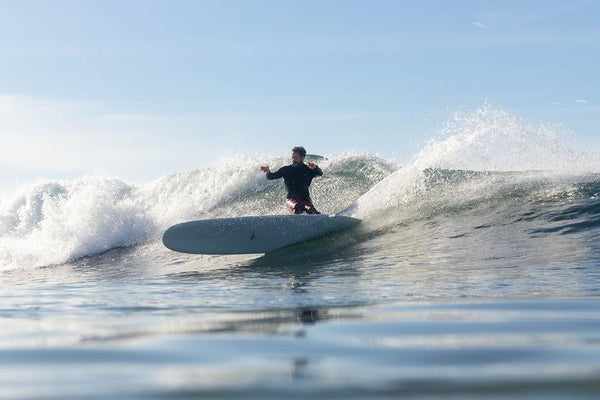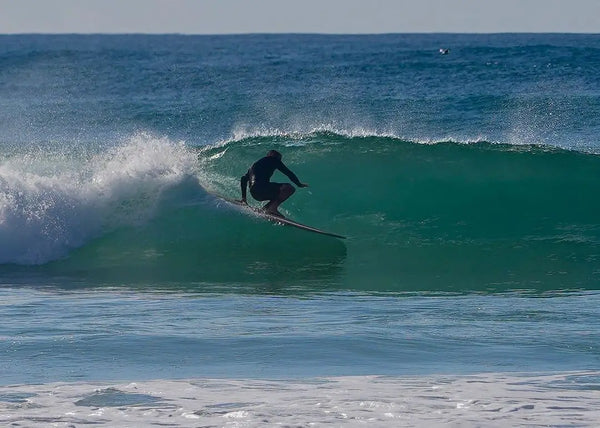CJ Nelson Sprout 2.0: Gear Review by Matt Rode
Share
Model: Sprout 2.0
Length: 9'6" (76.2 liters)
Construction: Thunderbolt Silver
Number of sessions: 20+
Types of conditions: Ankle to chest-high+ running walls, in conditions ranging from clean/offshore to blown out/onshore.

SHOP NOW
Paddling
I weigh 150 pounds and ride shortboards most of the time, so the ample 76+ liters of volume in this board meant I regularly caught more than my fair share of waves. Entry was exactly as you’d expect for a dedicated noserider—as long as you are in early and know how to position a log, the lack of rocker up front doesn’t matter. In steeper, slabbier waves (such as the double-up reef on the inside of Chuns), there was still enough volume to get in early, but I had to be quick with my setup to make sure the nose stayed above the surface.
Turning
This is a dedicated noserider, so it isn’t designed to turn. Add in the fact that I was using the 10" Flying Diamond Cali Pivot fin, and I definitely wasn’t doing long, drawn-out roundhouse cutbacks or hitting the lip. That being said, most of the turning being done on a board like this is to set up noserides, and the Sprout 2.0 performed that function perfectly. When it came to redirects to the pocket, I found that it was essential to turn from the tail, and that power turns such as drop-knee cutbacks were the most effective.
Walking the Nose
The Sprout 2.0 is about as stable as a noserider comes, which means that cross-stepping is extremely controlled and stable. You almost feel like you are walking on a sidewalk, which is exactly what you want out of a noserider, particularly when you are surfing steeper, critical walls, which are the types of waves I like to log. That being said, the lightweight Thunderbolt construction did feel a bit less stable than I believe the board would have been had it been built with traditional volan/polyurethane. (Note: For those who prefer heavier logs, it is possible to order a custom Sprout 2.0 in volan/polyurethane.)
Noseriding
This board noserides about as well as any log I’ve ever ridden. It is incredibly stable, provides lift while you are on the nose, and trims nicely through critical sections. In particular, I found that it noserides better than many comparable boards in flatter, softer shouldery sections, where some boards tend to bog. I could hang five pretty much anywhere on the wave, and had lots of long, extended hang tens, as well as heel hangs, one-footed kicks, etc. However, in extremely fast, hollow, deep sections, the board had a bit less hold on the nose than a pig/involvement-style design, such as the Apex.

Disadvantages
My biggest complaint about the Sprout 2.0 is largely a subjective one that reflects my preference for heavier, traditionally glassed logs. The Thunderbolt technology makes the board lighter and stronger than normal volan/polyurethane glass and resin, and the internal carbon stringers definitely create a lively flex feel that makes it possible to position the board for noserides more quickly and effectively than with a heavy log. However, I personally enjoy the feel of trimming on a heavier log, and I missed that feeling with the Thunderbolt construction.
The 2.0 version also features some edge in the tail, which is a new development. This is probably helpful for most people who aren’t used to riding longboards with soft, 50/50 rails, but I am a devout traditionalist when it comes to logs, so I personally prefer the older, softer rails in the back of the board on the original Sprout.
Finally, I tend to ride my logs a bit longer, and probably would have preferred the 10'0". That being said, it only took a few waves for me to figure out the board and shorten my cross-step, and once I did, the Sprout 2.0 was excellent for noseriding, particularly for a board that was six inches shorter than I normally log on.
Overall Review
Overall, this is probably one of the best dedicated noseriders that I’ve ever ridden—which isn’t surprising, since that’s exactly what it’s designed to be, and CJ Nelson is one of the best traditional longboarders in the game. It works well with any type of noserider, pivot, or drive fin, but it is probably a good idea to err on the side of length and stability when it comes to the fin, since this board isn’t really built to turn. (I prefer a minimum of 10 inches, and often ride 11" fins on my logs).
The updated 2.0 version has extra flip in the tail, which helps lock the board in the pocket and lift the nose during noserides. It also has a more pinched rail, which keeps the board in contact with the wave face. The edge that has been added to the rails back near the tail will be helpful for most people, but traditionalists might prefer the 50/50 rails of the original Sprout. In addition, the lightweight construction of the Thunderbolt technology, combined with the forgiving, responsive flex of the carbon fiber internal stringers, make this board easier to maneuver and position than other similar dedicated noseriders. However, traditionalists might prefer the heavier, more classic trim feeling on a volan/polyurethane version of the board.
Overall, the Sprout 2.0 blends traditional noseriding with a few modern tweaks and the lightweight construction of Thunderbolt technology (with Silver being the heaviest and most “traditional-feeling” version from Thunderbolt, but still quite a bit lighter than a normal volan/polyurethane board). This combination of features makes it a great noserider to travel with, particularly on trips that include flights.
SHOP SPROUT 2.0 SURFBOARD NOW
Read More 👈

1 comment
Hi Guys,
If you looked for the Best complement to a 9’3 Parallax, so as to start nose riding but in far from perfect conditions (no point break, either a mushy reef or a slabby beach, would you opt in for the Sprout 2.0 or another model? PS: due to spinal surgery I am a poor paddler.
Finally, what are your shipping costs to Belgium? And is the shipping coming from Europe (so as to avoid tax)?
Thanks!
All the best,